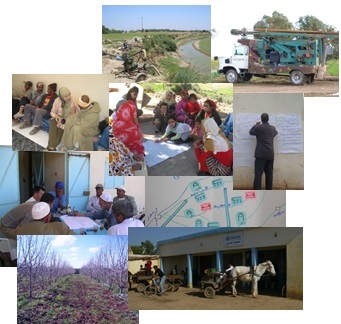Hajar Choukrani, Amar Imache, Hassan Kemmoun, Marcel Kuper, Ali Hammani, Abdelilah Taky, Guillaume Lacombe
DOI: https://doi.org/10.60569/9-a7
Numéro 9, octobre 2023
Résumé
Ce travail explore l’aménagement hydro-agricole des merjas centrales de la plaine du Gharb au Maroc, en suspens depuis plusieurs décennies. Différentes visions contrastées, quant à l’évolution et à la mise en valeur de ces zones humides temporaires, sont avancées par les institutions publiques, les considérant comme zones d’expansion des crues ou des zones peu valorisées et à intégrer dans un futur aménagement hydro-agricole. Pourtant les merjas sont intensivement exploitées par une diversité d’acteurs dans un contexte d’insécurité foncière et de multiples conflits d’usages. Focalisant sur la merja Sidi Ameur, une démarche de concertation a été menée, à travers des entretiens individuels, des focus groupes et des ateliers participatifs, invitant les acteurs locaux et institutionnels à coconstruire différents scénarios d’aménagement hydro-agricole. L’objectif de l’étude est de développer et tester une démarche pour rendre plus visibles les usages actuels et la vision des communautés locales afin de les engager, au même plan que les acteurs institutionnels, dans un processus de réflexion et de négociation. Dans un premier temps, la cartographie participative a permis de faire converger les participants vers une délimitation commune – hydrologique et juridique – des merjas. Ensuite, la phase prospective a permis d’identifier différents scénarios d’aménagement collectif, et d’explorer leur faisabilité technique et leurs impacts socio-économiques. Les ateliers montrent la focalisation agricole des parties prenantes, écartant tout autre destin des merjas (zones tampons, réserves écologiques). Pour toutes les options d’aménagement hydro-agricole, la question de qui est légitime pour la mise en valeur des merjas est posée, avec une forte demande d’assainissement foncier préalable. Nos résultats soulignent l’importance et la place de la concertation comme un outil de négociation pour mettre en exergue la position et les revendications des communautés locales souvent marginalisées dans les programmes publics.
Mots clés : aménagement ; participation ; foncier ; merjas ; gouvernance partagée
إشكالية الأرض، إشكالية الماء: مناقشة مستقبل المرجات بسهل الغرب، المغرب
ملخص
يستكشف هذا العمل جدوى ومآل التجهيز الهيدروفلاحي للمرجات الوسطى بسهل الغرب بالمغرب والذي ظل معلق يراوح مكانه منذ عقود. وتجدر الاشارة إلى أن لكل مؤسسة من المؤسسات العامة رؤية خاصة بشأن تطور وتطوير هذه الأراضي الرطبة المؤقتة، معتبرة إياها مناطق للحماية من الفيضانات أو مناطق غير مستغلة بشكل كامل ويجب دمجها في مشروع مستقبلي للتجهيز الهيدروفلاحي. ومع ذلك، تستغل ساكنة المحلية المرجات بكثافة في ظل إشكالية الوعاء العقاري وتعدد النزاعات على استخدامها. ومن خلال التركيز على مرجة سيدي عامر، تم إجراء مشاورات من خلال مقابلات فردية وجماعية وورشات عمل تشاركية، دعي فيها الفاعلون المحليون والمؤسساتيون إلى المساهمة في بناء سيناريوهات مختلفة للتجهيز الهيدروفلاحي. كان الهدف من الدراسة هو تطوير واختبار منهجية لجعل الاستعمالات الحالية للمرجات ورؤية المجتمعات المحلية أكثر وضوحًا من أجل إشراكهم، على قدم المساواة مع الفاعلين المؤسساتيين، في عملية التفكير والتفاوض على مستقبل هاته المرجات. في المرحلة الأولى، مكنت الخريطة التشاركية للمشاركين بالتقارب نحو تحديد مشترك هيدرولوجي وعقاري للمرجات. ثم، سمحت مرحلة الاستشراف بتحديد سيناريوهات مختلفة للتجهيز، واستكشاف جدواها التقنية وتأثيراتها الاجتماعية والاقتصادية. أظهرت ورشات العمل تركيز المشاركين على الجانب الزراعي، مستبعدين أي مصير آخر للمرجات (مناطق للحماية من الفيضانات، محميات إيكولوجية). بالنسبة لجميع سيناريوهات التجهيز الهيدروفلاحي، تُطرح مسألة من له الشرعية في تطوير المرجات، مع وجود طلب قوي لحل إشكالية الوعاء العقاري مسبقا. وتسلط نتائجنا الضوء على أهمية ومكانة التشاور كأداة للتفاوض من أجل إبراز موقف ومطالب المجتمعات المحلية التي غالبًا ما لا تأخد بعين الاعتبار في البرامج العامة.
الكلمات المفتاحية: التجهيز، المقاربة التشاركية، الوعاء العقاري، المرجات، الحكامة التشاركية
Agrarian question, hydraulic question: Debating the future of the merjas of the Gharb plain, Morocco
Abstract
This study explores the agricultural development of the central merjas of the Gharb plain in Morocco, which has been on hold for several decades. Public institutions have put forward contrasting visions for these temporary wetlands, considering them either as flood expansion zones or as little-valued areas to be integrated into future hydro-agricultural development. Yet the merjas are already intensively exploited by a variety of people in a context of land tenure insecurity and multiple conflicts of use. Focusing on the Sidi Ameur merja, a participatory process was carried out through individual interviews, focus groups and participatory workshops, inviting local and institutional stakeholders to co-construct different scenarios for hydro-agricultural development. The aim of the study is to develop and test an approach to make current uses and the vision of local communities more visible, in order to engage them, along with institutional players, in a process of reflection and negotiation. In a first step, participatory mapping enabled participants to converge on a common hydrological and legal delimitation of the merjas. Next, the prospective phase identified different development scenarios, and explored their technical feasibility and socio-economic impacts. The workshops demonstrated the stakeholders’ agricultural focus, ruling out any other destiny for the merjas (buffer zones, ecological reserves). For all hydro-agricultural development options, the question of who is legitimate to access the merjas is raised, with a strong demand for prior land reclamation. Our results underline the importance and place of concertation as a negotiation tool to highlight the position and claims of local communities often marginalized in public programs.
Key words: development; participation; land tenure; merjas; shared governance
